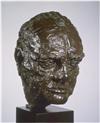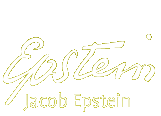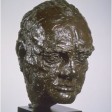The 1940s
 Epstein began the decade by publishing his autobiography, Let There be Sculpture, in 1940. In the same year he started carving Jacob and the Angel, which he exhibited at the Leicester galleries in 1942. The following year he was commissioned by a firm of Dutch art dealers to paint a series of flower studies. Epstein became briefly obsessed with this task; he abandoned sculpture temporarily and employed a gardener to ensure he had a continuous supply of flowers.When Epstein returned to sculpture he also returned to modelling in bronze. In 1944 he began work on Lucifer, his only major bronze sculpture inspired by a poem (John Milton’s Paradise Lost). The work was finished in 1945 and exhibited at the Leicester Galleries. It was offered as a gift to the Tate and the Fitzwilliam Museum in Cambridge, but both rejected it.
Epstein began the decade by publishing his autobiography, Let There be Sculpture, in 1940. In the same year he started carving Jacob and the Angel, which he exhibited at the Leicester galleries in 1942. The following year he was commissioned by a firm of Dutch art dealers to paint a series of flower studies. Epstein became briefly obsessed with this task; he abandoned sculpture temporarily and employed a gardener to ensure he had a continuous supply of flowers.When Epstein returned to sculpture he also returned to modelling in bronze. In 1944 he began work on Lucifer, his only major bronze sculpture inspired by a poem (John Milton’s Paradise Lost). The work was finished in 1945 and exhibited at the Leicester Galleries. It was offered as a gift to the Tate and the Fitzwilliam Museum in Cambridge, but both rejected it.
In 1946 Epstein was finally able to model the portrait of his neighbour Winston Churchill that had been commissioned by the War Artist’s Advisory Committee. The sittings took place in Epstein’s studio and at Chartwell, Churchill’s home in Kent.
In 1947 Lucifer finally found a home at the Birmingham Art Gallery and Epstein began to carve Lazarus, which was completed and exhibited in 1948. Epstein wrote that Lazarus “was inspired in the happiest possible manner” by “an idea which had haunted me for many years” but the carving was returned to his studio after the exhibition and was only sold four years later.
Epstein’s wife Margaret had been in ill health for some years during the 1940s and in 1947 she died. Epstein had the support of his mistress Kathleen Garman, but the loss of his wife understandably caused Epstein to feel anxious and insecure for months even though he was busy and selling work. His son Jackie was sent to stay with Peggy Jean Epstein in America.
Epstein made a brief visit to America in 1949. He also received a commission for Youth Advancing for the 1951 Festival of Britain.


